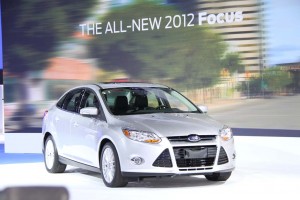
Ford wants to offer fuel-saving Stop/Start technology on products like the new Focus - if it can get federal regulators to acknowledge the technology's benefits.
Ford Motor Co. will begin offering so-called Stop/Start systems in a variety of its vehicles, technology the maker claims will be able to reduce fuel consumption by as much as 10%.
Globally, Stop/Start systems will be offered in about 20% of the maker’s product mix by 2014, noted J Mays, global design director, during a presentation at Ford’s Wayne Assembly Plant, on Tuesday.
Longer term, Ford officials added, Stop/Start could become fairly ubiquitous in the company’s line-up.
But while Mays hinted that Ford hopes to launch the technology in the U.S. market “quite soon,” he cautioned that federal regulators have yet to give Stop/Start their thumbs-up. With the nation’s fuel economy standard set to reach 35 mpg by 2016 – and possibly push to 62 mpg by 2025 – makers like Ford are reluctant to introduce anything that doesn’t gain them credits with regulators – as well as kudos from consumers.
(Ford plans to produce three battery cars at its newly-updated Wayne Assembly Plant, starting in 2012. Click Here for more.)
“We won’t bring it to market” in the U.S. without some acknowledgement from regulators at the Environmental Protection Agency that Stop/Start boosts mileage, stressed Mays.
The Stop/Start concept is fairly simple. Even a brief pause at a red light can use a significant amount of fuel. Idling, perhaps while in a bank or fast food line, can consumer several gallons an hour in a typical vehicle. So the technology automatically shuts a vehicle’s engine off when it would otherwise idle. When the driver’s foot lifts off the brake, the car automatically restarts, usually in only a fraction of a second.
Ford is by no means the only maker looking at Stop/Start technology – nor the only company reluctant to introduce the system in the U.S. without a government endorsement. Several European and Japanese makers have said they would move once the EPA acted. Until then, only a small number of brands are offering the technology in the States, notably including Porsche, which introduced Stop/Start, last year, on the new Panamera.
Unlike in Europe, where the technology is always active when the 4-door sports car starts up, the default on the American version of Panamera is to have Stop/Start disabled. A motorist must switch it on.
The EPA’s slow response to new technology has been frustrating automakers and delaying potentially fuel-saving technologies, industry experts gripe. On several European modes BMW, for example, is using a new system that disconnects the alternator from the driveline when the vehicle’s battery is charged up. That reduce frictional losses until the battery needs a kick and the alternator re-engages.
Government officials have responded by cautioning they don’t want to appear to endorse new technologies that might be promising on paper but which do little to improve mileage in real-world applications.
